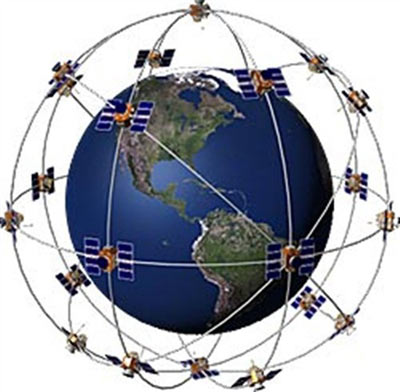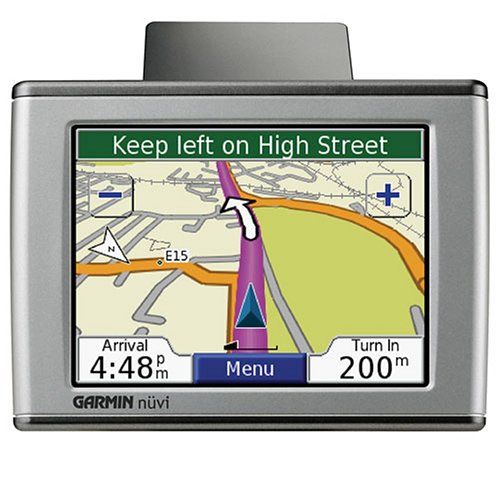GPS. Past, present and future through the eyes of a layman
Introduction
At the present time, when modern phones have become ten times more powerful than the first supercomputers when the first iPhone, iPad and many Android devices, we received a new ideology to use these resources. Pocket gadgets now not just reduced to the size of the palm computers, and the tools the user is using one finger to control all aspects of their lives – in all areas, which penetrated the Internet: communication, entertainment, travel, information search,
The list can be continued indefinitely. In many ways, the interweaving of Internet into our lives has contributed to GPS navigation. Now, when almost everyone is in the pocket GPS receiver a number of services had the opportunity to improve our lives. However, let us first consider the origin story of the GPS.
1. The history of the emergence and development of navigation technology
GPS (from the English. Global Positioning System) – satellite navigation system, providing a measurement of distance, time and determining the location of objects (see figure 1).

The project was implemented and owned by the war Department of the United States. The main objective of the project is to determine the current coordinates of the user on the Earth's surface or in near-earth space [4].
The idea of creation of satellite navigation was born in the 50-ies. In that moment, when the Soviet Union launched the first artificial Earth satellite, the American scientists led by Richard Kershner (Richard Kershner), watched the signal coming from the Soviet satellite and found that due to the Doppler effect the frequency of the received signal increases with the approach of the satellite and decreases with its distance. The essence of the discovery lay in the fact that if you know your coordinates on the Earth, it becomes possible to measure the position and velocity of the satellite, and Vice versa, knowing the satellite position, it is possible to define own speed and coordinates (see figure 2).

Implemented this idea has been in 20 years. The first test satellite launched on 14 July 1974 in the US, and the last of 24 satellites required for complete coverage of the earth's surface, was launched in 1993, thus, the global positioning system have taken on arms. It became possible to use GPS for precision-guided missiles at fixed, and then on the moving objects in the air and on the Ground.
Initially, global positioning system, was developed as a purely military project. But after in 1983 was shot down by intruder in the airspace of the Soviet Union, the Korean airlines plane with 269 passengers on Board, U.S. President Ronald Reagan allowed the partial use of the navigation system for civilian purposes. But the accuracy was reduced by the algorithm.
Then came the information that some companies have cracked the algorithm reduce accuracy on the L1 frequency and successfully compensate for this error component, and in 2000 this precision desensitization was abolished by the decree of the President of the United States [2].
Table below presents the chronology of development of GPS (see table 1).
table 1 - Chronology of development of GPS
Date Event
1973 Decision to develop a satellite navigation system
1974-1979 Test system
1977 Receiving a signal from the ground station, simulating a satellite system
1978-1985 Launching eleven satellites of the first group (Block I)
1979 the Reduction of funding for the program. The decision to launch 18 satellites instead of the planned 24
1980 In connection with the decision to curtail the program satellite Vela monitoring system of nuclear explosions, these functions, it was decided to hold the GPS satellites. The start of the first satellites equipped with sensors registering nuclear explosions
1980-1982 Further reduction of funding for the program
1986 Destruction of the space Shuttle the Space Shuttle "Challenger" suspended development of the program, as the latter planned to launch a second group of satellites. The result is the main means of transport was chosen as the carrier rocket "Delta"
1988 Decision on the deployment of an orbital group of 24 satellites. 18 satellites are not able to ensure the smooth functioning of the system
1989 Activation of the second group of satellites
1990-1991 Temporary disconnection SA (eng. selective availability is artificially created for unauthorized users to rounding location up to 100 meters) in connection with the Gulf war and lack of military models of receivers. The inclusion of SA 1 Jun 1991
8.12.1993 Message about the primary system readiness. In the same year a final decision on the granting of signal to the free enjoyment of their civil services and private persons
1994 Satellite constellation is equipped with
17.07.1995 Full system availability
1.05.2000 Disable SA for civil users, thus, the accuracy increased from 100 to 20 meters
26.06.2004 the Signing of the joint statement on ensuring complementarity and compatibility of Galileo and GPS
December 2006 the Russian-American talks on cooperation in the field of complementarity of space navigation systems GLONASS and GPS
2. GPS today
2.1. GPS – game
Revolution geotargeting services built around location of something (user or points on the map), it was possible to predict before the advent of newfangled smartphones. People started to go crazy for GPS navigation as soon as it spread. May 1, 2000 the press-service of the White House has announced that it discontinued the intentional degradation of the accuracy of civilian GPS receivers, and 3 may one of the fans GPS Dave Ulmer decided to test the navigation accuracy. He called this idea the "great American stash hunt using GPS" via the Internet and reported it to other users. The idea was very simple: somewhere in the forest hides a container and recorded its geographic coordinates. Other players have to find "treasure" using their GPS receivers. The rule for the finder: take some stuff, leave something of their own. Ulmer placed his own container (black bucket) near Portland. Together with the journal where the participants could mark their visit, and with a pencil he left small gifts of videotapes, books, CDs and a slingshot. For three days the stash was found by two players who had read about it online. Other enthusiasts began to place their own caches and post their coordinates, in supporting the endeavor. Like many other ideas on the Internet, a new game quickly gained popularity and eventually earned a new name – geocaching. The website Geocaching.com to this day it remains a popular resource for geocachers around the world, and Russia has a resource geocaching.su. The Russian version is slightly different from Western: the caches in the domestic version of the game are encouraged to establish in areas that have historical, cultural or natural value [1].
2.2. GPS tags
Based on the geocaching implemented the idea of GPS tags. Foursquare offers users to mark on the map of interesting places, bars, cafes, theatres, in other, everything that may be of interest to others. Thanks to this service much easier to find a bar where you have recently celebrated your friend, than to resort to an Internet search. However, foursquare is not less successful counterparts, as the Russian – AlterGeo and foreign – Gowalla. As these services evolve and within social networks: Facebook – Places, extra space, allowing you to report to a location and tag friends who are with you. We can assume that "Places" will permeate almost the entire world.
2.3. Virtual reality

However, this is just a browser and not Navigator, that is the point you can know only the distance that separates you, but how to pass it and that is between you, know will not work.
Interesting app released website "Around the world". It is able to determine location and automatically begins the story about the nearest sights. Pleased with the fact that there is a manual mode and, in the case of GPS error, it is possible to select the object of interest manually.
2.4. GPS maps
Of course, not to mention the main consumers of this technology on mobile maps. Google Maps is pre-installed in every decent smartphone, and "Yandex. Card" with more accurate today map of Russia, fight for our market, continually adding new features and services becoming better and more complex. Three-dimensional view and a quick vector map in Google against more competent navigation and more accurate raster maps from "Yandex". Absolute leadership in the mapping of congestion and car routing, but also almost became the "geotargeting Twitter om" user comments on the map of "Yandex" started recently against the regime of full car Navigator Google. More competent search for Russian names in "Yandex" against pedestrian routing with public transport at Google. To choose can be endless, but in the end each user are both cards. Is "Yandex" release of car navigation inside of maps, similar to Google, and it will forever change the market of GPS-navigation, giving us a choice of two free, rapidly updated and a compact Navigator. And it will make the usual GPS navigators archaic [1].
3. Who needs it?
What will help in the life of the GPS device to the ordinary person (see figure 4)?

The best program urban navigation will pave you route to a specific address. And if you ask, and several routes to choose from. And, if you chose one, and on the way decided to deviate from the recommendations, right there on the course, the route will be recalculated. She predicts the expected speed and the arrival time to the destination, guiding you to the place, each time warning in advance on the screen (and if you turn on voice mode, and voice) on the twists, turns, shifts and other simple, direct movements. And yet, if you have some kind of complex interchange, will automatically increase the image to full intelligibility and indicate, according to some of the sleeves need to move. Moreover, some programs (and attached inexpensive subscription services) allow to account for data on the real traffic, and offer more routes may be long, but at the moment more rapid. However, these services still only just beginning to develop and the infrastructure is designed to provide, is not yet fully established.
If we are talking about trips driving in a strange city, and the forest — abroad, here without a Navigator (connected to the smart program and provided with the latest maps, which are usually updated often via the Internet) is simply not enough [3].
Opinion
One can only imagine what kind of development will get navigation in the future. Maybe all the traffic, including personal vehicles, will be controlled by automatic computer systems, and navigation will control the movement, not letting go astray and preventing collision with other objects. It is possible to replace the GPS will come with more advanced technology to receive the signal at a depth of several kilometers and not lose accuracy from external factors. However, it's clear that development is just beginning.
bibliography
2. The history of satellite navigation systems [Electronic resource] / Unknown author // How the GPS system. — 2009. — Mode of access: www.glonax.ru/history-gps.html
3. Kozlovsky, E. the Art of positioning / E. Kozlovsky // Around the world. — M.: 2006. — No. 12. — S. 204-280.
4. Network satellite radio navigation / V. Shebshaevich [and others]. — 2nd ed. Rev. and extra — M.: Radio and communication, 1993. — 408 S.: ill.
Комментарии
Отправить комментарий